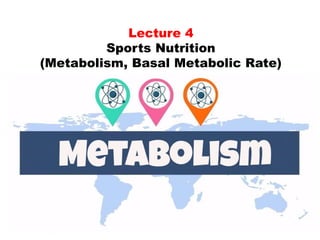
Lecture 4.pptx
- 1. Lecture 4 Sports Nutrition (Metabolism, Basal Metabolic Rate)
- 2. The breakdown of molecules to obtain energy is known as A.Anabolism B.Metabolites C.Catabolism D.Metabolism
- 3. Metabolism • Metabolism is a term that is used to describe all chemical reactions involved digestion and the transport of substances into different cells, in maintaining the living state of the cells and the organism. • Metabolism is closely linked to nutrition and the availability of nutrients. • Metabolism can be conveniently divided into two categories: – Catabolism - the breakdown of molecules to obtain energy – Anabolism - the synthesis of all compounds needed by the cells
- 4. Catabolism • Catabolism is the set of metabolic pathways that breaks down molecules into smaller units that are either oxidized to release energy or used in other anabolic reactions. Catabolism breaks down large molecules (such as polysaccharides, lipids, and proteins) into smaller units (such as monosaccharaides, fatty acids, and amino acids, respectively).
- 5. Anabolism • Anabolism is the set of metabolic pathways that construct molecules from smaller units.These reactions require energy. Anabolism is powered by catabolism, where large molecules are broken down into smaller parts and then used up in cellular respiration. Many anabolic processes are powered by the hydrolysis of adenosine triphosphate (ATP).
- 6. Chemical compounds involved in the process of metabolism is known as ___________ a) Metabolites b) Radicals c) Catabolites d) Intermediates
- 8. BASAL METABOLIC RATE • Basal metabolic rate (BMR) is the total number of calories that your body needs to perform basic, life- sustaining functions. These basal functions include circulation, breathing, cell production, nutrient processing, protein synthesis and ion transport. • Since your basal metabolic rate is based largely on involuntary functions like breathing and pumping blood, changes in your day- to-day activity don't do much to raise or lower this number.
- 30. TDEE is calculated by adding four numbers together: basal metabolic rate, thermic effect of feeding, exercise energy expenditure, and non-exercise activity thermogenesis. TDEE = BMR + TEF + EEE + NEAT THERMIC EFFECT OF FEEDING (TEF) When calculating TDEE one has to take into account how much energy is required to digest the food consumed. This is the thermic effect of feeding. To calculate TEF simply multiply the BMR by 0.1. Example: BMR = 1600 1600 x 0.1 = 160 calories burned as the thermic effect of feeding. EXERCISE ENERGY EXPENDITURE (EEE) The third variable in the TDEE calculation is exercise energy expenditure (EEE). This is the amount of energy one expends during exercise. There is no exact calculation for this as EEE is unique to everyone but a rule of thumb is that it can range from 250 calories for light exercise to 500 for intense exercise. Example: A beginner client that workouts for an hour = 250 EEE An advanced client working out for an hour plus = 500 EEE
- 31. NON-EXERCISE ACTIVITY THERMOGENESIS (NEAT) The fourth and final variable is non-exercise activity thermogenesis (NEAT). This accounts for the number of calories a client burns in their everyday life outside of exercise, whether that be from walking their dog, sitting at their desk job all day, or working manual labor. For NEAT there is no exact calculation and again it ranges from 250 calories to 500 calories depending on the activity during the day. Example: A sedentary desk job employee = 250 NEAT A delivery driver or construction worker = 500 NEAT SAMPLE TDEE CALCULATION: The client weighs 80 kg BMR = 1600 TEF = 160 EEE = 250 NEAT = 250 TDEE 1600 + 160 + 250 + 250 = 2,260
- 36. Which of these would be the most accurate measure of REE in an ICU patient? a)Harris-Benedict equation b) Indirect calorimetry c) Schofield equation d) 25 kcal/kg
- 37. The Revised Harris-Benedict BMR equation is as follows: Metric formula for men BMR = 88.362 + (13.397 × weight in kg) + (4.799 × height in cm) - (5.677 × age in years) Metric formula for women BMR = 447.593 + (9.247 × weight in kg) + (3.098 × height in cm) - (4.330 × age in years)
- 38. The Mifflin - St Jeor BMR equation is as follows: Metric formula for men BMR = (10 × weight in kg) + (6.25 × height in cm) − (5 × age in years) + 5 Metric formula for women BMR = (10 × weight in kg) + (6.25 × height in cm) − (5 × age in years) − 161
- 39. Calculating your daily calorie requirement If you are sedentary (little or no exercise) Calories Per Day = BMR x 1.2 If you are lightly active (light exercise or sports 1-3 days/week) Calories Per Day = BMR x 1.375 If you are moderately active (moderate exercise 3-5 days/week) Calories Per Day = BMR x 1.55 If you are very active (hard exercise 6-7 days/week) Calories Per Day = BMR x 1.725 If you are super active (very hard exercise and a physical job) Calories Per Day = BMR x 1.9
- 40. Indirect calorimetry involves the measurement of: a.Accelerometry b.heat loss c.resting metabolic rate d.oxygen consumption
- 41. Which of the following is not a characteristic of direct calorimetry? a.Measures metabolic heat production b.Uses oxygen consumption to estimate energy expenditure c.Measures temperature change of water to assess energy expenditure d.Requires the use of a metabolic chamber